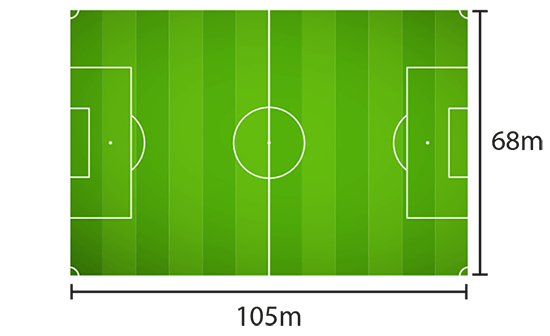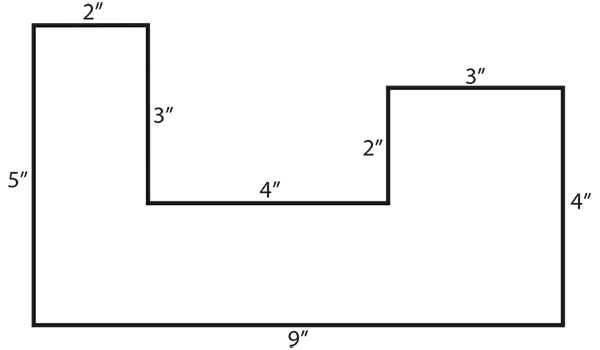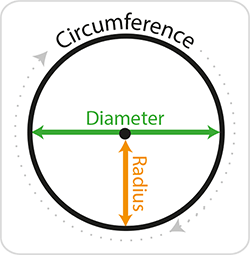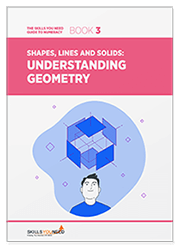Perimeter and Circumference
See also: Three-Dimensional ShapesLike many mathematical terms, the word perimeter has its origins in the work of early Greek mathematicians. It is derived from the Greek words ‘peri’, which means ‘around’ and ‘metron’, which means ‘a measurement’. Perimeter is literally a measurement around.
In everyday usage, you may have come across phrases such as perimeter fence, estate perimeter, or perimeter security. These mean that the fence, or the security provision, are around the edges, the outer limits or extremities of a measured area of land or property.
Understanding how to calculate perimeter is a useful mathematical skill for both study and real life, whether performing geometric calculations, marking out a playing field or replacing a fence.
Perimeter or Boundary?
The definition of a boundary is a dividing line between two areas. In cricket, the boundary is the line marking the edge of the pitch.
The perimeter is the measured length of such a boundary. In geometry, it is defined as the sum of the distance of all the lengths of the sides of an object. Perimeter is measured in any unit of length, e.g. metres, centimetres, miles or inches. For more on this, see our page on measurement systems.
So in common language, the two are often used interchangeably. However, in a mathematical context, we only use perimeter.
A circumference is a very specific type of perimeter, that refers only to circular shapes and forms. More on this later.
Measuring Perimeter of Regular Polygons
The perimeter of a two-dimensional shape is the total length of all the sides added together.
For example, the perimeter of a square, with a side length of 6m, is simply four lots of 6m, i.e. 4 × 6m = 24m. The square has four sides of equal length, which are added together.

A square of any side length s therefore has a perimeter equal to 4 × s, or simply 4s .
Perimeter vs. Area
Don’t get confused between perimeter and area. Whilst perimeter is the measurement of the outline of the shape, area is the measurement of the space contained within the perimeter.
So whilst perimeter is measured in units of length, area is measured in square units, e.g. m2, cm2 or inches2.
For more on measuring area, see our page on Calculating Area.
You can use the same principle to work out the perimeter of any regular polygon that has any number of sides of equal length:
If your polygon has n number of sides, all of length s, then its perimeter is always equal to n × s, or simply ns.
So for example, if you have a heptagon (7 sides) with side length 15cm, then the length of the perimeter is 7 × 15 = 105cm.
For more on regular, irregular and other polygons (straight-sided shapes), including a helpful chart with illustrations, see our page on properties of polygons.
Measuring Perimeter of Irregular Polygons
A regular polygon has all sides and internal angles equal, irregular polygons do not.
A rectangle that is not an exact square, for example, has two pairs of sides of equal length, but all four sides are not the same length.
Example
Find the perimeter of a rectangular football pitch, measuring 105 × 68 m.

The lengths of the opposite sides are equal to each other, so you need to add together two lots of 105m and two lots of 68m.
2 × 105 = 210m
2 × 68 = 136m
210 + 136 = 346m
The perimeter of the pitch is 346m.
Irregular polygons can be formed by any combination of straight lines that join up to enclose an area. No matter how complicated the shape, the perimeter will always be the sum of the lengths of the sides.
The shape below could be a garden plot, or anything else you can think of. In geometrical terms, it is an eight-sided enclosed 2D shape, which has no sides of the same length, and no internal angles of the same size.

It is an irregular octagon (8 sides) and its perimeter is equal to a + b + c + d + e + f + g + h.
Example
Calculate the perimeter of the template below, dimensions are in inches.

Starting at the bottom left corner and working your way around the shape in a clockwise direction, add up the lengths of the sides:
5 + 2 + 3 + 4 + 2 + 3 + 4 + 9 = 32 inches.
The perimeter of the shape is 32 inches.

Circumference
Circumference is a specific type of perimeter that applies exclusively to circular shapes.
Measuring the circumference of a circle
The mathematical expression for calculating the circumference of a circle is:
2 × π × radius or simply 2πr
The diameter of a circle is equal to twice the radius, so the expression for circumference can also be written πD.
Pi π
π (pi) is a Greek letter, which is used in mathematics to represent a constant with an approximate value of 3.142 (it is an irrational number with infinite decimal places). For more on this, see our pages on circles and curved shapes and special numbers.
Example
The groundskeeper needs to re-paint the lines on the football field in the example above and needs to know how much paint to buy. He has calculated the perimeter of the field and he also knows the length of the halfway line as this is the same as the short side of the pitch. He is also confident measuring the perimeter of the penalty areas, as these are also simple rectangles. However, he needs to know the circumference of the centre circle.
He has measured its radius and it is 9.15m.
Circumference = 2πr
2 × π × 9.15 = 57.5m (rounded to one decimal place)
The circumference of the centre circle is 57.5m.
Measuring the circumference of an ellipse
Not all curved shapes are perfectly circular and sometimes it might be necessary to find the perimeter of an ellipse (a squashed or elongated circle).

The perimeter:
$$p \approx 2\pi\sqrt{\frac{a^2+b^2}{2}}$$You can see that this expression is similar to the expression for the circumference of a circle, but radius r is replaced by \(\sqrt{\frac{a^2+b^2}{2}}\), where a and b are half the length of the minor axis and major axis respectively. (For more on ellipses, see our page on circles and curved shapes).
This equation only provides an approximation (≈). The more elongated the ellipse becomes, the more inaccurate the answer. Mathematicians have come up with several complex formulae for solving this problem. None of them have achieved 100% accuracy in a mathematical sense, but it is unlikely that you would need such a high level of precision unless you work in engineering or design.
Tools of the trade
There are many professions and occupations that may require you to take physical measurements of perimeters and boundaries, such as civil engineering, surveying, landscape architecture, garden design and sports ground maintenance.
It is necessary to not only have an understanding of the basic mathematical principles above, but also more advanced numeracy tools, such as trigonometry. It is not only the lengths of the lines that are important, but accurate measurement of the angles between those lines.
Apart from mathematical knowledge, there is also an interesting and varied toolkit needed for these sorts of occupations. Relatively short distances can be measured using steel tapes, or measuring wheels. Electronic distance measurement (EDM) devices, which use electromagnetic waves, are more often used by land surveyors. These are used in conjunction with other instruments such as levels and theodolites, which ensure the accuracy and precision of angular measurements, using a mathematical technique called triangulation.
However, if you just need to replace your garden fence, you will probably be fine with just a tape measure and a ball of string!
Further Reading from Skills You Need
Understanding Geometry
Part of The Skills You Need Guide to Numeracy
This eBook covers the basics of geometry and looks at the properties of shapes, lines and solids. These concepts are built up through the book, with worked examples and opportunities for you to practise your new skills.
Whether you want to brush up on your basics, or help your children with their learning, this is the book for you.
Conclusion
Perimeter is the mathematical term used to define the total length of the edges of a multisided two-dimensional enclosed shape (polygon). In the case of circular shapes, it is called a circumference.
Many professions require these mathematical skills, often used in conjunction with much more complex geometry and trigonometry. However, a basic understanding of the principles will allow you perform jobs around the house and garden with more mathematical confidence. You will now be able to work out how many bricks are required to go around the edge of a circular pond!
Continue to:
Calculating Area
Circles and Curved Shapes

